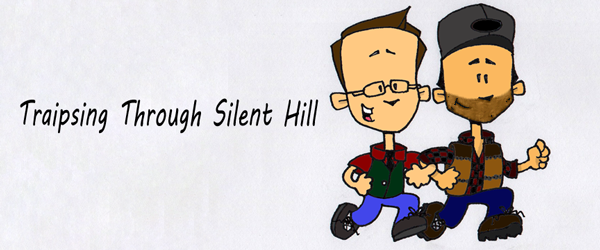
Artwork Graciously Provided by the Incredibe Steven Luna
Part Twenty-Three, or Picking Nits
I hope your weekend was restful, friends, because we are nearing the end of our time in Zerorigins. That’s right: Travis’s journey into the dark and “scary” world of horror is coming to a close, and with it is an end to bonking monsters over the heads with televisions, filing cabinets, and other pieces of junk that our loyal comrade somehow manages to carry with him all at once. Rest assured, however, there are still things to do.
Last time, we had just managed to retrieve Helen’s wedding ring, giving us the month of June. The 12th was circled on the month of “Fish” in the regular world’s room 500. Travis’s lucky quarter has “61” etched onto it. Smash them all together and we get a date for the rotary calendar puzzle—June 12th, 1961. So we embark on an epic quest across the motel to get back to the reception office, except it’s really boring since I’ve killed just about everything in the motel. Luckily I can still run through pools of blood and get Travis’s feet to go “thrp thrp thrp” all the way to my destination.
It’s the little things that make life worth living.
Anyway, we examine the rotary calendar again. There’s an engraving underneath the numbers: “In Memory of Happier Times”. Nullrigins doesn’t actually draw your attention to this, but it’s there (~3:00 in the video—don’t worry, it’s from earlier in our jaunt through the motel so nothing will be spoiled). Anyway, punching in the appropriate date causes a hole to pop open, and we have to put in Helen’s wedding ring. This summons all the black magic in the world into creating a key to room 500 on the wall behind Travis.
Black magic has lost a lot of power in these modern times, let me tell you.
So, I told you that I had more to complain about regarding the quarter, and it’s right here. It’s probably going to be really boring, because it involves the “official” timeline of the series. So feel free to skip the following side note.
SIDE NOTE: So, according to the “official” timeline, 1961 is when Richard Grady kills himself. I question this for several reasons, but the main issue is the fact that Travis’s quarter is named the Lucky Quarter when you look at it in his inventory. He clearly holds this item of great value for a reason that is revealed in a future flashback. Why on earth would he, presumably, carve the year of his father’s death into a quarter and then keep said quarter on him at all times, all the while insisting that it was “lucky”? I read that it is an “ironic” name, but that suggestion is stupid.
If you examine the item, Travis said he had it “when his parents died”, yet he doesn’t grasp the significance of the “61” scratched into the surface. So he knows that he had the quarter with him when his parents died, but has no idea why “61” would possibly be on said quarter? Unlikely. Travis may not be the brightest bulb, but he would at least know the year his parents died.
This also suggests that he wasn’t the one to carve the number in the first place. Sure, you could always play the “traumatic event amnesia” card, with its +2 defense against plot holes, but then how does he know the quarter is from when his parents died and not just something he always had with him? Traumatic amnesia only works as plot spackle when it doesn’t generate more holes.
Also, the puzzle we just solved has the phrase “In Memory of Happier Times” etched on it. I’m not saying that Richard didn’t kill himself on the anniversary of his wedding, but that’s all it would be—the anniversary. The “happier times”, coupled with the engagement ring we plugged into the hole to fully solve the puzzle, is clearly referring to the wedding, not Richard’s suicide.
Look, I guess it’s possible that one of the quarters that Travis got from his dad to play pinball was selected by Trav to become his lucky quarter. And I guess in a dissociative fugue, the younger Grady carved the shit out of the metal in order to commemorate the year he walked in on his dad’s corpse hanging from the ceiling and his mother “dying”. Either that or his dad decided it would be a productive use of his time to carve the year he committed suicide onto a quarter that he gave to his son because he loves the idea of messing with preteens.
Or the Silent Hill version of "A Wizard Did It"-esque plot hole. Source.
And I suppose that the historical distance between those events made it so his brain no longer associated the number 61 with the year of horrible trauma. Instead, he just knows that a coin he had with him when his parents died is a lucky, lucky thing that he must keep on him at all times, despite it being present when he became a fucking orphan.
Or, you know, the lucky quarter was his dad’s and was given to the young Travis because his suicidally depressed father felt that he didn’t need it anymore due to the fact that he felt his life was in freefall. And the kid kept it because it was the last positive memory he had of his dad.
Sigh. Look, I’m probably wrong “officially” or whatever I know I'm officially wrong, but if you make your audience have to
go through the kind of bullshit mental gymnastics to make something work, you’re telling a story
really poorly. And if my understanding (it’s their wedding anniversary) is so vastly difference from
the canonical explanation (it’s when Richard died), there is a fundamental disconnect between
storyteller and audience.
(After reading through earlier entries, notes in the asylum do indeed prop up the 1961-as-Richard's-suicide-year. So why the confusion? First is just a simple matter of tangential information: the plaque says "In Memory of Happier Times" and not "To the Tragedies that Shape Us" or something identifying the date as a tragedy. But the bigger problem is that the notes in the asylum, while they have dates, don't require the audience to commit the dates to memory like Richard's quest does. My confusion, then, stems mostly from only having 1961 constantly reiterated as a year of importance, while the time Mrs. Grady spent in the asylum is never as central to the player's progression. In this case, Climax did indeed cover their bases, but, as a player, I was only trained to notice dates in relation to Richard's suffering. I still think it could have been handled in a way that sets up the chronology more clearly, but it is still assuredly my error, not theirs.) END SIDENOTE.
On the way back to room 503 and our inevitable confrontation with whatever weird-ass thing Richard Grady has turned into, a single enemy respawns to put up a very stupid roadblock between Travis and his goal. It ends poorly for the taffyman. Travis slips through the mirror in room 503 and heads out into the southern block of motel rooms.
We transition to a blue flashback cutscene of young Travis approaching room 500. It’s such a great little sequence, showing the hapless child walking toward tragedy. I mean, we know exactly what he’s going to find in the room, and that dread works to build a really smothering tension. In fact, this whole level has been building up to a conflict that only the most dimwitted of players wouldn’t see coming. Even the weirdass confrontation with the Butcher and Dr. K/Lisa don’t really diminish the sense of falling down a pit toward some waiting horror.
It’s a shame so many motel rooms were empty.
But we’re nearing the boss, and we’re gonna have to send him back to hell! Room 500 initially consists of a long stairwell downward, taking about fifteen seconds to march down. Take a deep breath, hoist your AK-47 knock-off, and prepare for murdering your psychological holdups Travis. Shit’s about to get serious.
Through the door lay a blue-filter flashback, so let’s get that out of the way. Young Travis, flush with pinball victory, stumbles on his dad’s hanging corpse. He still has a quarter left, and he offers it to his father, which is probably one of the most heartbreaking moments in Silent Hill. You know, outside of the myriad crimes against humanity and all. And then, because this scene still isn’t tragic enough, Travis asks his dad to wake up. This poor kid!
Then HOLY SHIT RICHARD STARTS TALKING. He says that he wasn’t sleeping, and then scolds Travis for knowing that. He asks why Travis stood there for so long, and that “wasn’t right”, concluding it with, “That wasn’t healthy, son.”
Well, gee dad, neither is slipping a noose around your neck, but you don’t see me being a prick about it.
But instead of my awesome one-liner about the dead guy, we snap out of blue mode to the “real” mirror world (Christ, how many fucking layers of reality are there?). Travis says, “Daddy, this is insane.” Because all the other weird and hostile shit he’s encountered thus far is totally normal, but his dad coming back from the dead and chatting with him while he’s strung up from the ceiling? Totally nuts.
Richard intones very seriously that it’s time for Travis to face up to what happened and that he and Helen will see their boy in heaven. Hold up there, Dick—I think Travis has long since come to the same conclusion that the player has, unless you and Helen weaned him off breast milk with lead paint.
And face up to what, monstrous shit-for-brains? That his mother was still alive in a mental institution while he was under the impression she was dead because you—an authority figure he trusted—told him she was? Yeah, got that. That his dad was depressed over his wife’s situation and killed himself out of a lovely combination of despair and undiagnosed depression? Think he got that too. And what, praytell, will facing up to this reality change, other than the fact that Travis should be aware of any symptoms that his parents had?
Ooooh, I get it. The moral of Silent Hill: Origins is actually that we need to be aware of our family’s medical histories and schedule routine checkups with doctors who aren’t a bunch of corrupt, patient abusing fuckwits. I’m not quite sure where the psychic girl and cult fit in quite yet, but I’m sure we can figure something out.
Oh, wait, shit, Richard has revealed his true form! And it’s really stupid! Remember how, despite the anti-woman nature of it, I was actually pretty praising of the fuck-monster’s design because of its cohesive aesthetic and recognizable—though horrific—use of clear form? Richard Grady is a fucking mess. I have no real clue what the hell I’m looking at, and there’s nothing that really seems to be of any kind of substantial symbolic value.
Like, there’s a giant tumorous noodle monster-thing with a mouth pinned to the wall. It’s flanked by two sets of legs in various states of mangling, I suppose? One is upside down and the other isn’t, but… um… meat? Like, is this just random meat parts?
But I ask this, just like I asked for Mrs. Grady: HOW IN THE FUCK IS THIS, IN ANY WAY, REPRESENTATIVE OF RICHARD’S LIFE OR DEATH?
Anyway, this boss fight is in a tiny, cramped room (quelle surprise!). Unlike all the other boss monsters, Mr. Grady is immobile save for his creepy, stretchy noodle neck. His main method of attack is throwing up blood at a distance or biting you if Travis wanders too close. Yes, the former attack looks vaguely like a dick spraying blood, which is delightful. To hamper Travis and lure him in closer to a biting attack (which is probably more damaging, but I didn’t find out), two noodles drop from the ceiling that will choke Travis if they get close enough.
Oh, and said noodles don’t have to actually be near Travis’s neck—they will pretty much snag you if you’re in the same postal code. I’m pretty sure that, like the Ariels’ strangling attacks, these serve more to lock you in place unless you are complete shit and fail the “smash X to not die” quick time event and, shockingly, die.
So, Richard Grady is easily the most bullshit boss in the entire game, which isn’t much of a challenge considering one could potentially sleep through all the other bosses and still knock out a victory. Still, the tight space, quick attacks with short refractory periods, ceiling noodles, and Travis’s insistence of not breaking into a run until his gun is firmly at his side all lead to a situation where our trucker’s kidneys are turned into slush.
For the record, I only got hit during a boss fight with the first taffyman, and that was because I was fucking about, trying to be cute with my weapons. This thing, however, will almost guaranteed win a damage race if you don’t have healing items.
But perseverance will win the day, and by that I mean about 52 assault rifle bullets will win the day. And I still have a whopping 47 bullets left over! My other weapons, untouched by the scourge of Richard “Cock Monster” Grady, have tons of ammunition left over—77 .22 caliber rounds, 18 shotgun shells, 46 .45 bullets, 48 rifle shells, and 12 .44 magnum rounds. Travis is basically just a roaming gun store at this point—I could probably go through the rest of the game killing every monster with guns and still not have to worry about running out of tiny projectiles to launch at their dumb faces.
Huh? Oh, right.
Richard flops over dead and his tongue hilariously pops out of his mouth. Another paperweight—“Truth”—materializes on the floor in the middle of a sigil. After the note last time mentioning that this is a Flauros or whatever, it’s kind of cool that the mark these things appear in is a triangle. It fits with the whole “Flauros can tell you stuff but he’ll only tell the truth if he’s in a triangle because reasons” from dubious mythology.
So, we pick it up and Travis wonders how all this chicanery is possible before asking Alessa directly why she won’t let him out. The he calls to her to show herself and—surprise!—she appears from behind him because Climax may have made some boneheaded decisions, but that particular bit of symbolism was not one of them.
He asks Alessa if she’s happy, and further verbally accosts her with, “You’ve dug up my parents. What now? When do we get to look inside your sick little mind?” Travis, buddy, I know you’re hurting, but she’s not the enemy. She’s also, like, eight years old. Also, she’s an insanely powerful psychic capable of killing with a thought. So you may want to cool it just a bit.
Alessa actually looks a bit put out for about two seconds before remembering that she is basically a kickass murder god now and thus gives precisely zero fucks about what people think. As such, she glares at Travis and he falls over dead.
Join me next time for a retrospective on the motel level, Why Did They Backload All The Good Design in This Game?
< PREVIOUS ENTRY • NEXT ENTRY >
Advice • Fiction • Gaming • General Musings • Reviews






